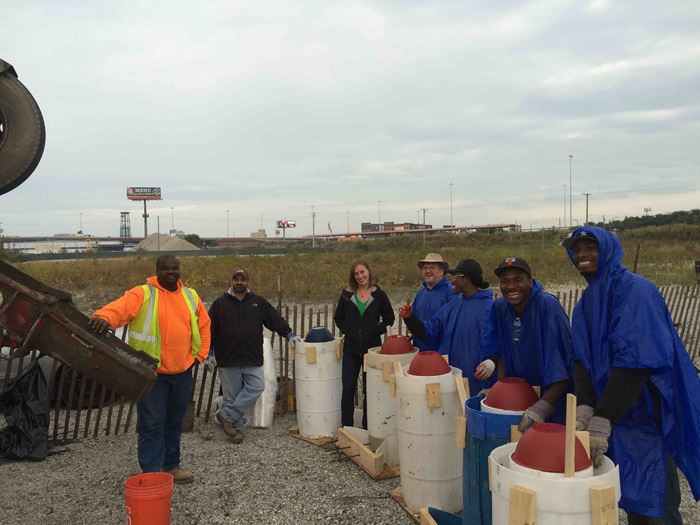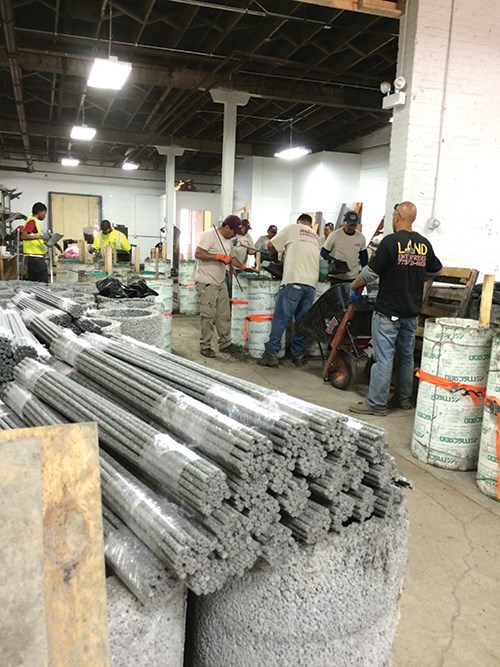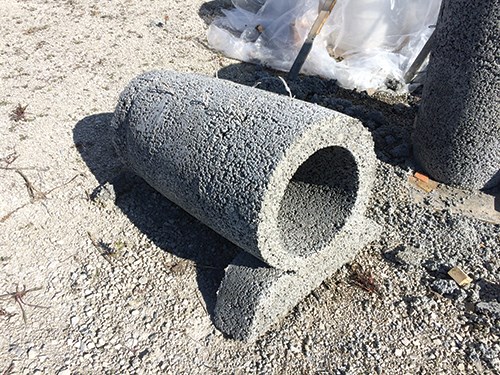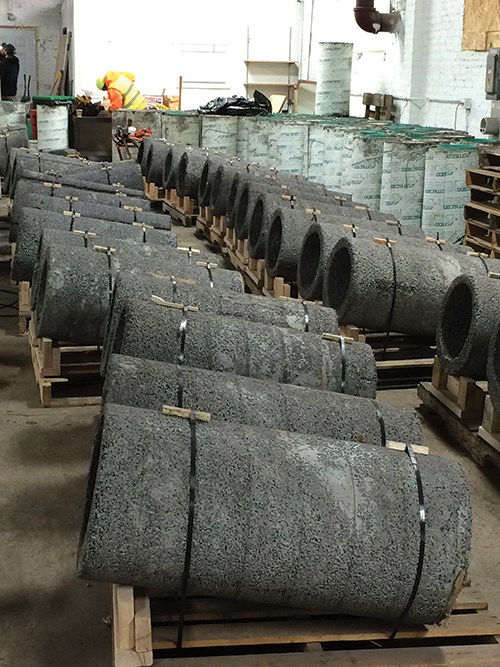Composite rebar strengthens riverbed “catfish houses”
Basalt-reinforced polyester rebar eliminates rust and spalling and extends the useful life of concrete catfish spawning and habitat units in Chicago River environmental restoration effort.
More than a century of engineering effort has made the Chicago River — a 251-km long system of rivers and canals that snakes through urban Chicago, IL, US — into what the American Society of Civil Engineers (ASCE, Reston, VA, US) today considers a “civil engineering monument of the millennium.” One result? Water quality has improved dramatically in the past 30 years, according to Margaret Frisbie, executive director of the Chicago-based conservation group Friends of the Chicago River (Friends). A downside, however, is that in many areas of the system, the downed trees and natural riverbanks that created good fish habitat and would ordinarily be present have been replaced with concrete seawalls, thus preventing the return of healthy fish populations to the now improved river environment. To address the loss of fish habitat and encourage healthy repopulation, Friends worked with the Illinois Department of Natural Resources (IDNR) to design nesting cavities for channel catfish, a native species that surveys had shown should be more abundant in the system. The simple cavity design mimicked an underwater hollow log. It was designed using 31-cm-diameter PVC pipe cut to 81-cm lengths and attached by steel cables to concrete blocks to weigh the pipes down and keep them on the bottom of the river. The plan was to install 400 fish habitat and spawning units (FHSUs), introduce 100,000 baby channel catfish, donated by IDNR, that would mature in the river and, ultimately, see them use the FHSUs as nesting cavities.
Before FHSU production began, Friends had an opportunity to consult with Brian Lutey, VP – sustainability at Ozinga Green Building, a division of Ozinga Bros. Inc., a Chicago-based builder and concrete supplier. He examined the initial FHSU design and suggested that there was a better way to make them.
Lutey is active on the board of another non-profit called Urban Habitat Chicago (UHC, Chicago). The group’s mission is to demonstrate the viability of green infrastructure, urban agriculture and materials reuse/recycling, and to work with disadvantaged and at-risk youth. He knew a microbiologist and fish expert from that board, so they met to discuss the needs of catfish and the possibility of using Ozinga’s Filtercrete “pervious” concrete in FHSUs.
Pervious concrete is fairly porous. Thanks to use of the chunky aggregate that creates pores in its finished structure, it’s often used in parking lots of green buildings to encourage rainwater to infiltrate soils rather than run off to overloaded storm drains. The biologist already knew that pervious concrete’s pores help to clean water by trapping large particles (mechanical filtration) and by providing habitat for microbes and invertebrate colonies, which eat organic matter (chemical filtration) and, in turn, are eaten by fish fry (baby fish) and larger vertebrates. The pores also would help reduce the structure’s mass.
Because the FHSUs were intended as permanent installations, that’s where composites entered the picture. In an aquatic environment, steel rebar would quickly rust and contribute to premature unit failure, but Lutey knew composite rebar would resist corrosion and withstand long-term underwater exposure to freeze/thaw cycles. To find a source of composite rebar, Lutey turned to Dr. Mohsen Issa, Ph.D., P.E., S.E., professor of structural and civil engineering at the University of Illinois – Chicago, who is well known for his work on high-performance concrete and rapid bridge replacement. Issa put Lutey in touch with RockWerk Systems Inc. (Naperville, IL, US), which was working with composites consultancy Allied Composite Technologies LLC (ACT, Rochester Hills, MI, US) to develop North American-produced basalt-reinforced composite rebar.
“We’ve been working with Dr. Issa for about 10 years on different types of basalt rebar,” explains RockWerks partner, Jack Rigsby. “I brought the first composite rebar over from Russia 12 years ago when I was head of R&D at Dukane Precast [Naperville, IL, US]. Dukane built the first building in the US I’m aware of that was reinforced in key sections with basalt rebar for Argonne National Laboratory [Lemont, IL, US]. They needed a building free of steel because their equipment created magnetic fields around anything ferrous, which affected their readings. When we tested basalt rebar, we found it was three times stronger than steel, easy to install and didn’t rust, so we asked ourselves ‘why aren’t we using it here?’”
Tony Celucci, another RockWerk partner adds, “We’ve had Dr. Issa test basalt rebar from many manufacturers to check product consistency, quality and fiber content across various sizes of rebar. We found they varied dramatically — from 60% to 83% fiber in some cases. Since there didn’t seem to be any established standard for quality control, we decided to partner and establish a strategic supply chain where we could control everything from rock to finished product.” In addition to ACT, RockWerk currently is partnered with basalt rovings producer Mafic SA (Kells, Ireland), resin supplier Ashland Inc. (Columbus, OH, US) and an unnamed pultruder. RockWerk arranged to supply #3 (10-mm diameter) basalt-reinforced unsaturated polyester rebar to Lutey for the project.
Generation 1 into the water
After evaluating nine FHSU prototypes, the team was ready to make its first production batch in fall 2014. Ozinga supplied pervious concrete, and labor was provided by UHC staff plus youth from two other Chicago-based non-profits: Empowerment through Education & Exposure (EEE), which exposes underprivileged youth to educational opportunities and activities that build knowledge and skills; and BUILD Chicago Inc., which works with at-risk and gang-involved youth to develop alternative lifestyles. Additionally, UHC president, Larry Asimow, owner of Larry Asimow Landscaping Inc., a local landscape contractor, agreed to provide extra labor and construction equipment.
Because one of UHC’s missions is to promote materials reuse/recycling, the team used a lot of “found” materials to produce the FHSUs. Donated 208L plastic drums became the outer “mold” (form) for the concrete and cardboard concrete forms formed the hollow center. The latter didn’t prove durable enough, so the team switched to PVC pipe that was split lengthwise to allow a wooden strip to be inserted. A plastic ball sealed off the top of the pipe so concrete didn’t get into the center opening when it was poured into the barrel. During the forming process, polymer-based rope loops were pushed through the structure’s walls to form anchors for fans of geotextile “kelp,” which also was bonded in place with plastic sealer and foam.
Each FHSU used four lengths of composite rebar and featured a separate concrete “foot” designed to keep the end farthest from the stream bank up off the riverbed so it wouldn’t fill with sediment. A soybean-based sealer/curing/release agent for the pervious concrete (The Bean, C2 Products Inc., Arcadia, IN, US) was used, and each unit was wrapped in a plastic bag to help speed cure by ensuring the concrete didn’t dry out. When the concrete was fully cured, the wooden strip was removed, which provided space to pull out the PVC pipe. The first units weighed 163-181 kg and measured 0.91m long, with an outside diameter of 46 cm, an inside diameter of 34 cm and 5.1 to 6.4-cm-thick walls. Lutey reports they achieved an extremely robust cure. “You could hit the FHSUs with a hammer and the concrete wouldn’t break,” he recalls.
The first 50 units were trucked to preselected sites, lifted by boom onto a barge, and set onto the river bottom by a team from Friends and IDNR just before the river froze. By that time, Friends and IDNR had already released 55,000 channel catfish fry into the river.
Lighter Generation 2 deployed
This May, IDNR and Friends surveyed the pilot site via underwater camera and found that the FHSUs hadn’t moved or sunk into the riverbed, so the team moved forward with plans to make another 350 units this spring and summer. Since then, 100 units have been produced and installed, but with design changes to improve handling and stability. The geotextile kelp was eliminated and the concrete foot was replaced by wooden risers. To reduce weight so FHSUs were easier to transport, the concrete was modified with a lighter aggregate, reducing unit mass to about 100 kg. This time, FHSUs were lashed, several feet apart, to wooden pallets in pairs before they were placed into the river. The thinking was this would keep the fish houses from sinking into the silt should the riverbed erode. (The pallet wasn’t expected to rot very quickly since the water is fairly anaerobic.) However, this design also proved challenging because the pallets tended to flip over in the water, and banding that held the FHSUs to pallets could loosen. “This is an evolving project,” concedes Lutey. “The design is still changing.”
Friends and IDNR have since released the remaining 45,000 catfish fry plus an additional 100,000 to help build a strong population. Frisbie notes that the IDNR does fish surveys across the state on a rotating basis and will check progress in areas where FHSUs have been placed in about three years. “It’ll be a little while before we find out how the catfish are doing, but hopefully, the FHSUs turn out to play a strong role in their return.”
Related Content
JEC World 2023 highlights: Recyclable resins, renewable energy solutions, award-winning automotive
CW technical editor Hannah Mason recaps some of the technology on display at JEC World, including natural, bio-based or recyclable materials solutions, innovative automotive and renewable energy components and more.
Read MorePlant tour: Daher Shap’in TechCenter and composites production plant, Saint-Aignan-de-Grandlieu, France
Co-located R&D and production advance OOA thermosets, thermoplastics, welding, recycling and digital technologies for faster processing and certification of lighter, more sustainable composites.
Read MoreCirculinQ: Glass fiber, recycled plastic turn paving into climate solutions
Durable, modular paving system from recycled composite filters, collects, infiltrates stormwater to reduce flooding and recharge local aquifers.
Read MoreWatch: A practical view of sustainability in composites product development
Markus Beer of Forward Engineering addresses definitions of sustainability, how to approach sustainability goals, the role of life cycle analysis (LCA) and social, environmental and governmental driving forces. Watch his “CW Tech Days: Sustainability” presentation.
Read MoreRead Next
Plant tour: Daher Shap’in TechCenter and composites production plant, Saint-Aignan-de-Grandlieu, France
Co-located R&D and production advance OOA thermosets, thermoplastics, welding, recycling and digital technologies for faster processing and certification of lighter, more sustainable composites.
Read More“Structured air” TPS safeguards composite structures
Powered by an 85% air/15% pure polyimide aerogel, Blueshift’s novel material system protects structures during transient thermal events from -200°C to beyond 2400°C for rockets, battery boxes and more.
Read MoreDeveloping bonded composite repair for ships, offshore units
Bureau Veritas and industry partners issue guidelines and pave the way for certification via StrengthBond Offshore project.
Read More
.jpg;width=70;height=70;mode=crop)































